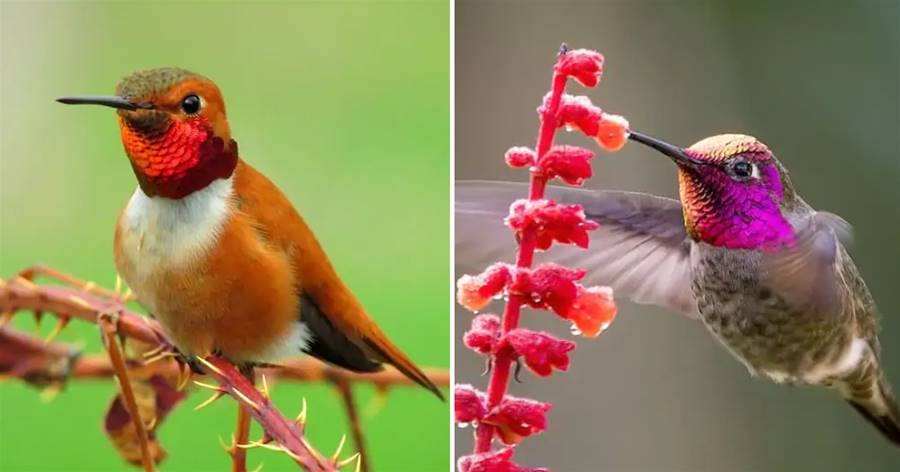

There are over 30 hummingbird species that spend at least part of the year in Canada, the United States or Mexico. In this article we will look at 25 types of hummingbirds in North America, including all the species typically found in the U.S. and Canada.
Let’s take a quick look at each of these beautiful species, starting with one of the most well-known North American hummingbirds.
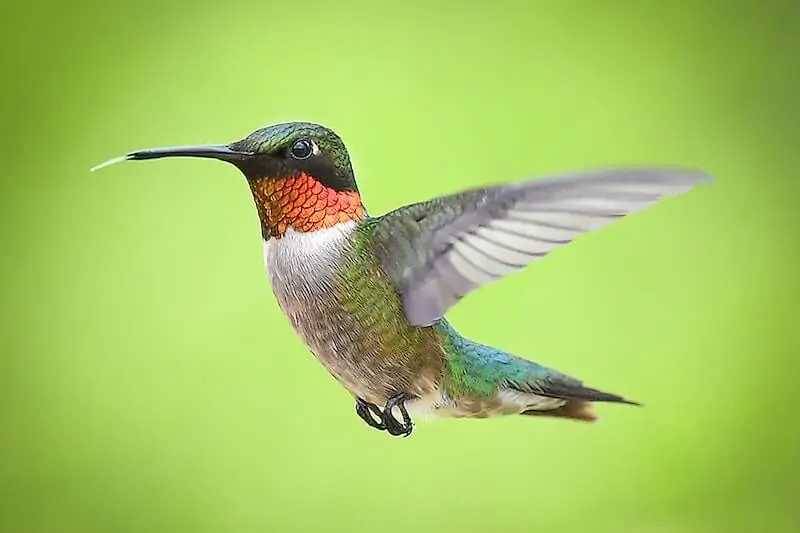
Scientific name: Archilochus colubris
Range: Winter: southern and eastern Mexico, Yucatan Peninsula, Central America.
Ruby-throated hummingbirds are the only hummingbird to breed east of the Mississippi River. So for a large portion of the U.S. and Canada, they are the only hummers around. Each spring they enter the U.S. in droves from their wintering grounds in Central America. Many of them cross the Gulf of Mexico, over 500 miles, in a single non-stop flight. Eagerly awaited, they show up in the Gulf states in March and make their way north to Canada by mid-May.
These hummingbirds have a green back and white underparts.
Ruby-throated hummingbirds regularly visit and seem to have adapted well to suburban environments.

Scientific name: Calypte anna
Range: Pacific coast, southern Arizona, northwestern Mexico
stay in the U.S. all year within most of their range, however they stick closely to the states along the west coast. The green of their feathers tends to be a bit brighter and more iridescent than most others, and even their chest and belly are sprinkled with emerald feathers.
They are happy in backyards and love gardens and eucalyptus trees. In fact, it is thought their range has expanded due to planting of exotic trees, plants, and flowers, in gardens and recreational areas. They can even be found as far north as the Alaskan panhandle in the winter months.
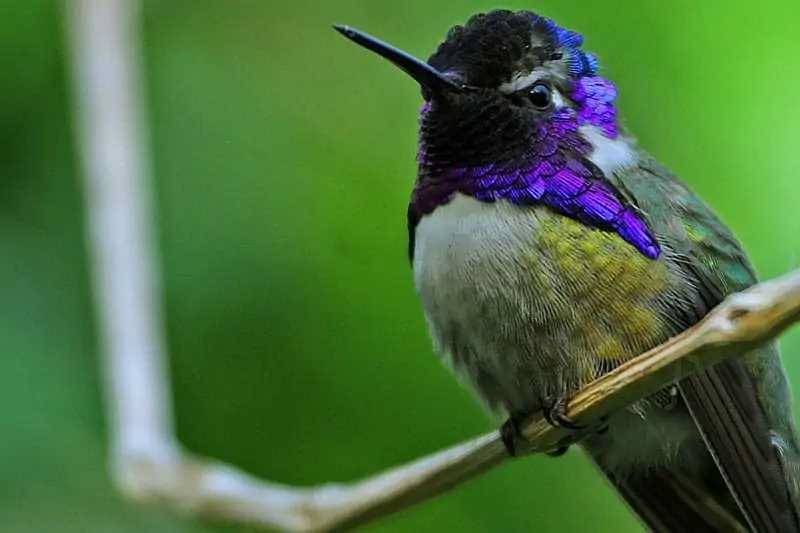
Scientific name: Calypte costae
Range: Year-round: far southern California, Baja California (Mexico), and the Sonoran Desert in southwestern Arizona and northwestern Mexico.
Male are known for their deep purple faces. They have a splash of purple on their head as well as their throat, with purple feathers flaring out on both sides like a mustache. Females have a green back, a pale grayish head and cheek, and pale underparts.
Males perform unique courtship displays, diving and rocking in front of females with face feathers flared out like purple fingers. Costa’s hummingbirds are more shy than other species, but can still be attracted to backyard feeders.
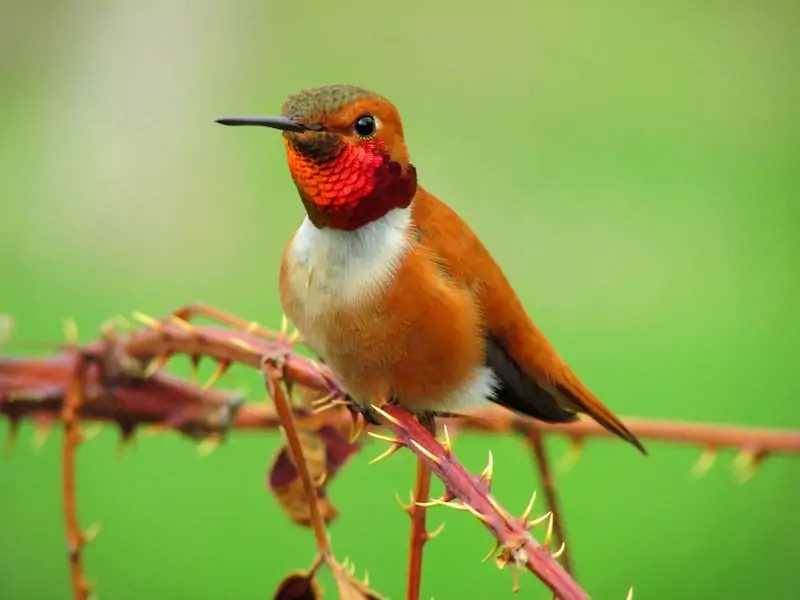
Scientific name: Selasphorus rufus
Range: Winter: coastal southern California, Gulf coast, south-central Mexico. Spring: Washington, Idaho, Oregon, British Columbia up to southern Alaska
The rufous breeds further north then any other hummingbird species, making it all the way up to Alaska. In fact, those that winter in Mexico then travel to Alaska make a round trip of nearly 4,000 miles! This makes the rufous one of the furthest .
Rufous hummingbirds, although small, are known for being aggressive.
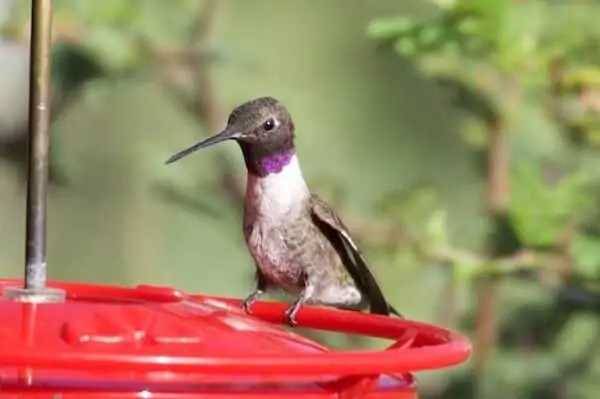
Scientific name: Archilochus alexandri
Range: Year-round: coastal southern Texas, Rio Grande Valley through south central Mexico. Winter: within year-round range, southwestern Pacific coast of Mexico, U.S. Gulf Coast
Black-chinned hummingbirds migrate north from Mexico and Central America each year and breed in the western United States. Males throat color looks plain black in most light, however they do have a small strip of purple feathers along the bottom.
Females appear like most hummingbird females green above and pale below with a plain throat. They are widespread among many habitats from deserts to mountain forests and like to perch on bare branches.
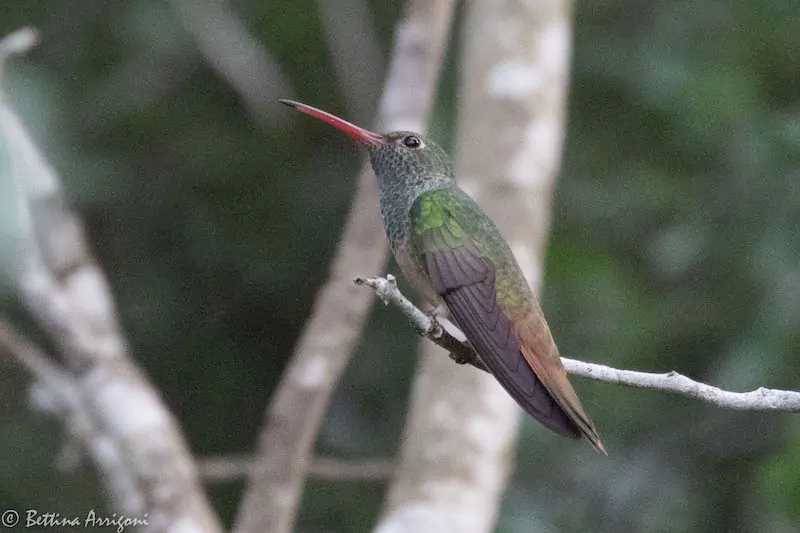
Scientific name: Amazilia yucatanensis
Range: Yucatan peninsula and eastern coast of Mexico, some migrate north to the U.S. Gulf Coast in the winter.
The defining features are their red bill, bluish-green throat feathers and a light buffy colored belly. They also have rusty brown on their tail feathers, which is hard to see unless they fan them out. Unlike many U.S. species, males and females do not have any significant differences in plumage.
Buff-bellied hummingbirds live along the eastern coast of Mexico, and the only place to reliably see them year-round in the U.S. is just over the border in the lower Rio Grande valley of Texas.
The buff-bellied hummingbird is larger than many common U.S. species, and will tend to dominate over smaller species around food sources. They have been observed chasing away smaller hummingbirds while loudly vocalizing.
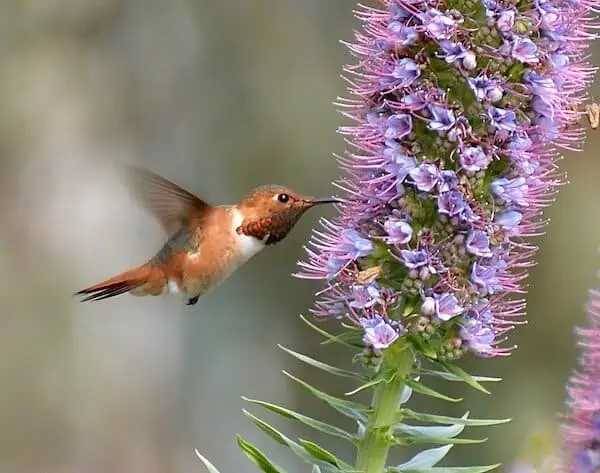
Scientific name: Selasphorus sasin
Range: Winter: central Mexico Spring: Pacific coast from southern Oregon down to southern California. Year-round: Los Angeles and the Channel Islands.
has very similar coloring to the rufous hummingbird. Allen’s males are orange with a green back and orangey-red throat.
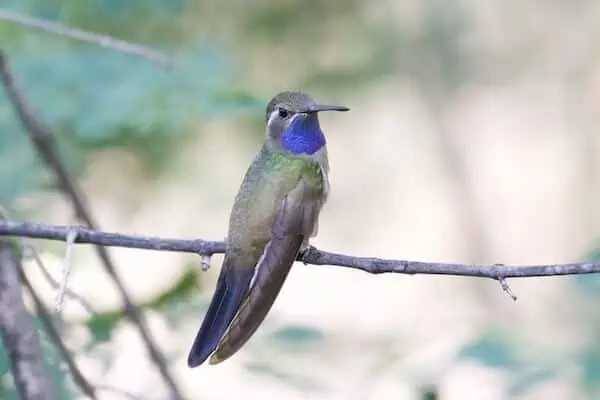
Scientific name: Lampornis clemenciae
Range: Mexico with small breeding populations southeastern Arizona, southwestern New Mexico and western Texas.
The blue-throated mountain gem is the largest hummingbird species to nest in the United States.
They mainly only come to the U.S. during the breeding season however may stay into the winter if they find a particularly good feeding station. They stick closely to shaded canyon streams.
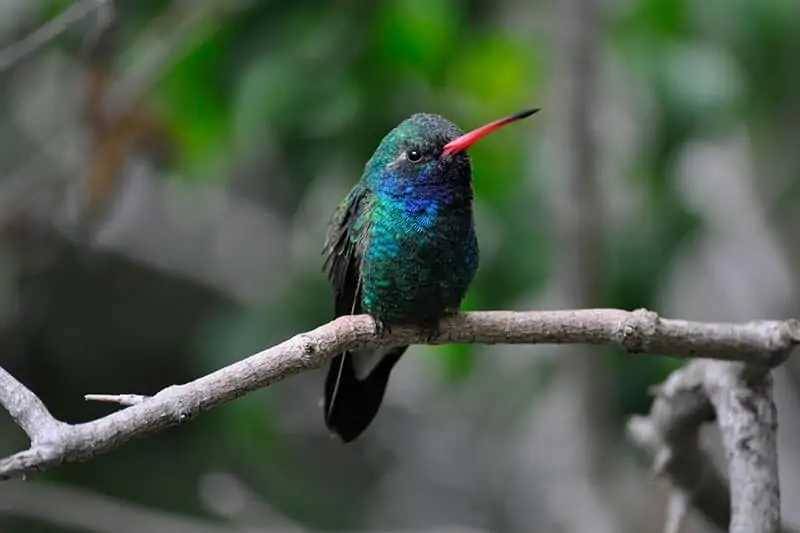
Scientific name: Cynanthus latirostris
Range: western and southern Mexico, southern Arizona and New Mexico
The only two states in the U.S. where the broad-billed hummingbird is known to breed are Arizona and New Mexico. Males are hard to mistake with their indigo throat and blueish-green belly. They also have an orange beak with a black tip. Females are a washed out green above and grayish below with the typical black beak.
When courting a female, the male will fly back and forth in a shallow arch, like a swinging pendulum or pocket watch.
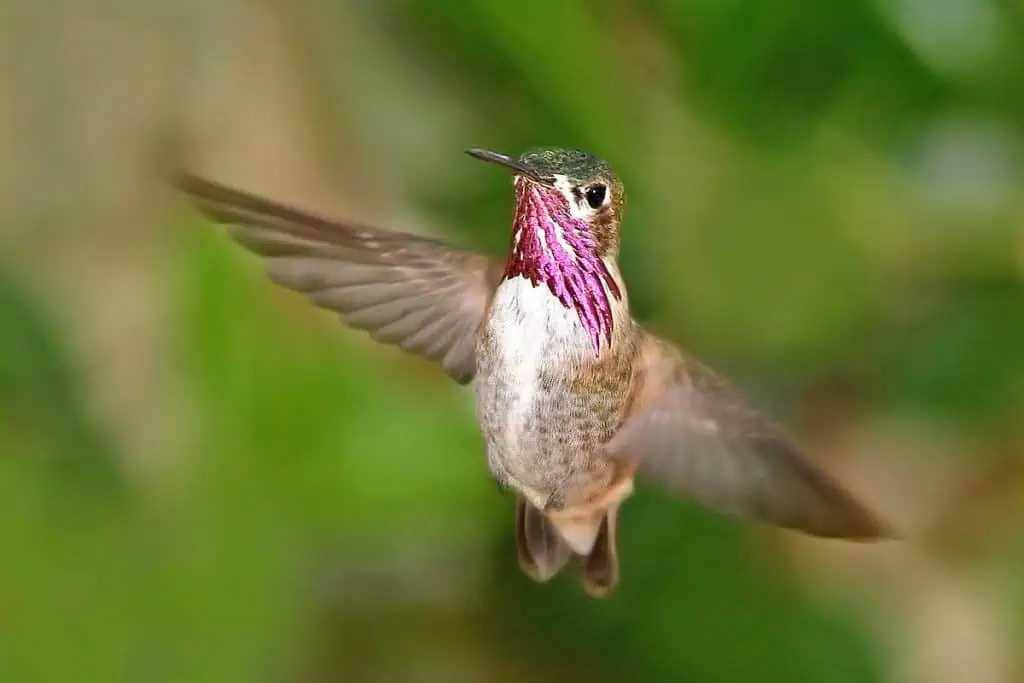
Scientific name: Selasphorus calliope
Range: Winter: southwestern coast of Mexico Summer: southeastern British Columbia, along the southwestern border of Alberta, parts of California, Oregon, Washington, Idaho, Montana, Wyoming and UtahADVERTISEMENT
The mainly spends winters along the southwestern coast of Mexico, then heads north to the Pacific Northwest and parts of western Canada to breed. This is an impressively far migration, especially considering the calliope is the smallest bird in the United States!
Males have a unique throat pattern of magenta stripes that fork down on the sides. Females are plain with some green spotting on the throat and peachy tinted underparts.
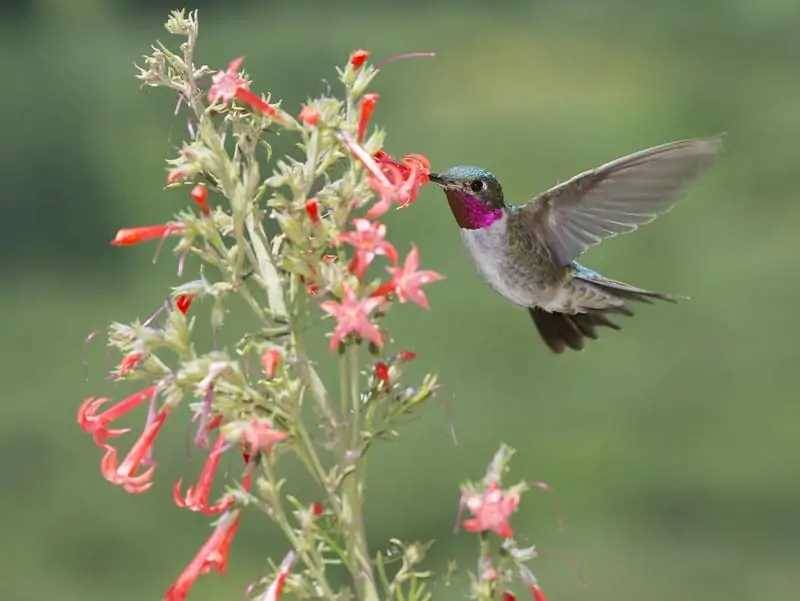
Scientific name: Selasphorus platycerus
Range: Winter: throughout Mexico and northern Central America. Summer: U.S. southwest, Idaho, California and Wyoming.
Broad-tailed hummingbirds love the mountains and breed at elevations up to 10,500 feet. Because temperatures can get quite cold overnight at these high elevations, broad-tailed hummingbirds are known to when they sleep, a deeper hibernation-like state that conserves energy.
Males have a rosey-magenta colored throat. Females have some green spotting on their throat and cheeks, and buffy colored sides.
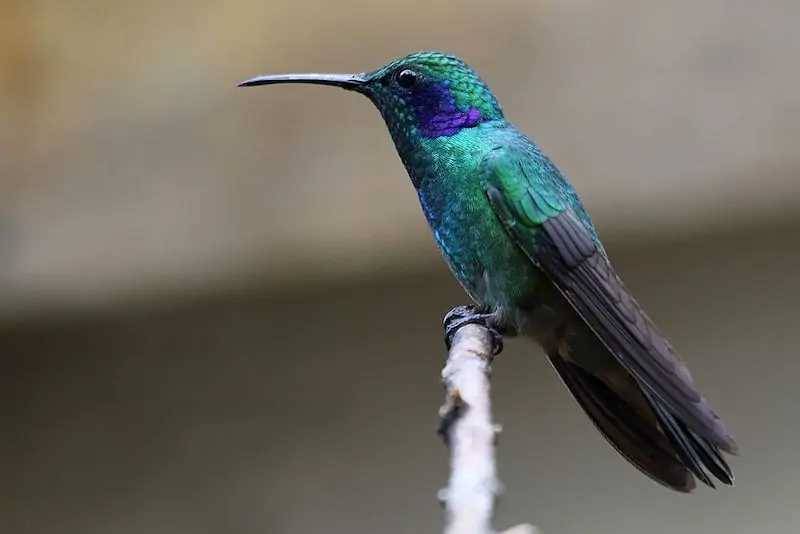
Scientific name: Colibri thalassinus
Range: southern Mexico and northern Central America
Also known as the Green violetear, these hummingbirds are not known to breed in the United States, however there have been sightings in many eastern states, the majority in Texas. They are larger hummingbirds with a vibrant green body, dark wings, and a patch of iridescent blueish-purple across their cheek and chest.
While they do drink from feeders they don’t stick around long, and spend more of their time hunting for insects.

Scientific name: Eugenes fulgens
Range: Year-round throughout Mexico and parts of Central America. Some enter the U.S. to breed in southern sections of Arizona, New Mexico and Texas.
The Rivoli’s hummingbird was formerly known as the “magnificent hummingbird”. Males have a dark purple head with a brighter teal colored throat. Unless the sunlight catches their colors just right, they often look overall dark.
They are larger than most hummingbirds seen in the U.S., with a longer bill and slender body. Unlike some other larger hummingbirds, it doesn’t exert much dominance over other hummers at flowers and feeding stations.
They are mainly found in Mexico and like shady canyons and mountainous forests. Rivoli’s are only regular visitors to Arizona and New Mexico, but every now and then one will stray into another state.
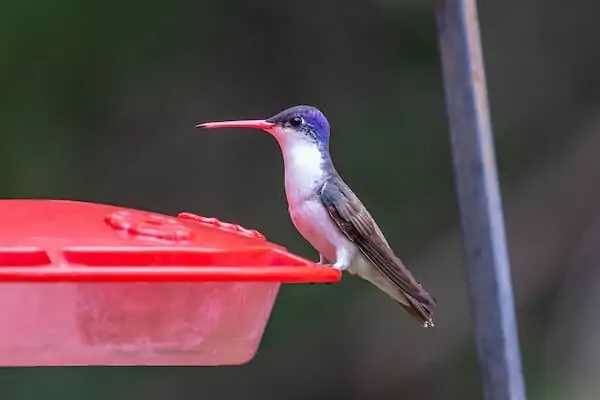
Scientific name: Leucolia violiceps
Range: Year-round along the western coast of Mexico, some move further north to breed and may just barely cross the border into Arizona.
Common in Mexico, this little beauty has been known to occasionally cross the border into the southwestern U.S. They have a dark gray back with a pure white chest, belly and throat. Males and females have a purple cap on their head and an orange beak with black tip.
These hummingbirds tend to live in middle elevations, in canyons lined with sycamore trees.

Scientific name:
Range: resident in western and southern Mexico, Guatemala, Honduras and El Salvador.
The berylline hummingbird has very woodsy colors with a fully green head and chest, brown back, cinnamon streaks on the wings, and underparts that are either light or buffy. These Mexican hummingbirds have made just a few appearances in the U.S. in Texas (Big Bend National Park), Arizona and New Mexico (Guadalupe Canyon).
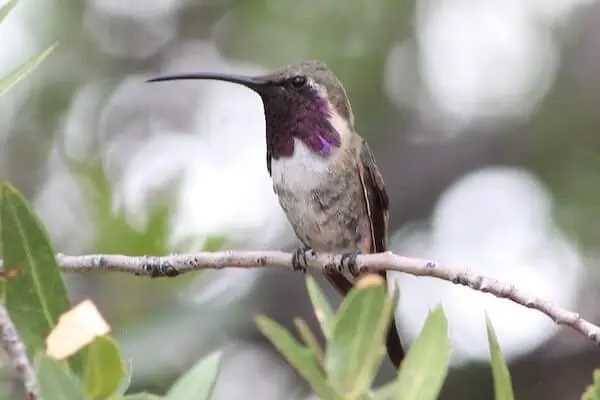
Scientific name:
Range: Mexico’s central plateau, some enter the U.
The male lucifer hummingbird sports a magenta-purple throat that extends down onto their upper chest and flares out at the sides. Females are green above, pale below with cinnamon on their sides and a cinnamon patch on the upper tail feathers. They also have a long bill that is curved downwards and a long forked tail. This gives them a distinctive shape compared to other U.S. visiting hummingbirds. Their preferred habitat is canyons and scrub with agave and cacti.
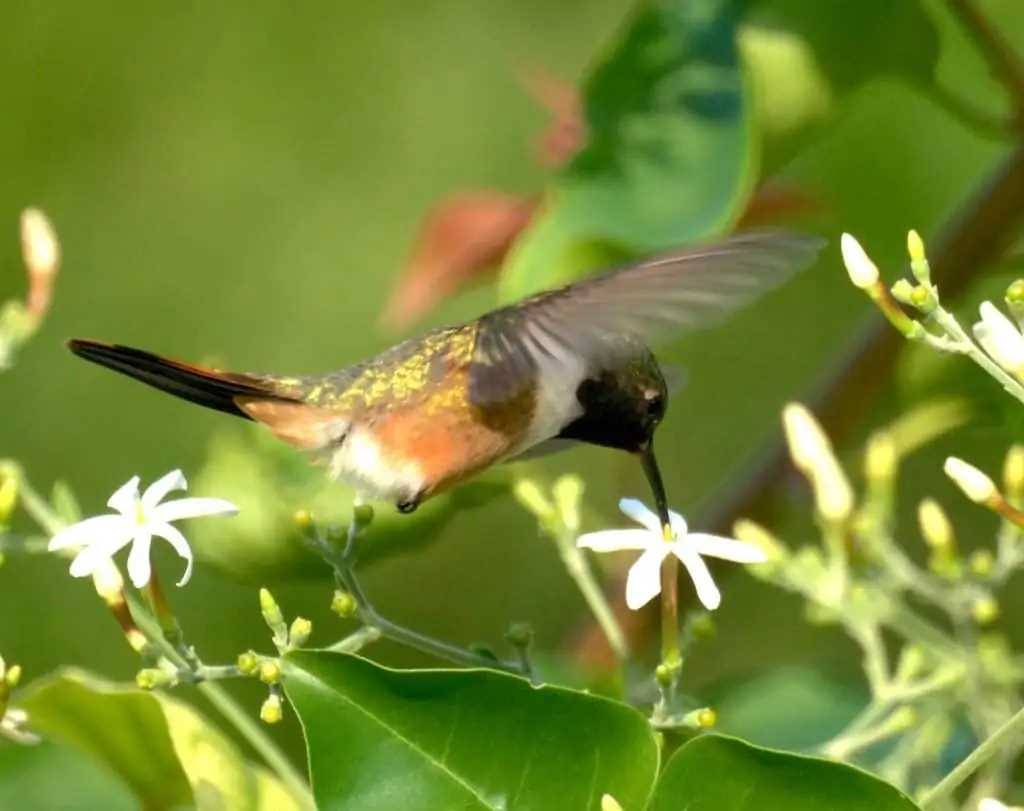
Scientific name:
Range: Throughout the Bahamas and Turks & Caicos Islands
The Bahama woodstar is a small hummingbird with a green back, buffy sides, and orange along the tail edges. Males sport a purple throat that often looks appears black. These hummingbirds are found in wooded and scrubby habitats, forest edges, and are at home in gardens.
They do not move with the seasons, and nest year-round in the Bahamas. A few have been spotted along the southeastern coast of Florida, however it is not common.
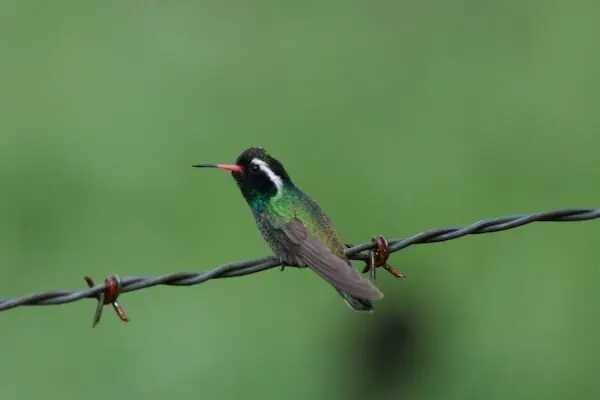
Scientific name:
Range: western and southern Mexico, northern Central America to Nicaragua.
The white-eared hummingbird is at home in Mexico and Central America, where it prefers clearings and edges of coniferous forests at higher elevations. They do occasionally cross the border into southern during the summer, enjoying backyard feeders.
Both females and males have a dark head with a large white stripe behind the eye, a green body and dark wings. Males have an orange beak with black tip, while female’s beak is mostly dark. Males also sport a blueish-green throat and some purple on the face which often looks black.

Scientific name:
Range: Dry forests of western Mexico and Central America down to Panama
The plain-capped starthroat is a larger hummingbird with a noticeably long bill. Other good identifying features are the dark stripe through the eye and white patch on the rump. Males and females are similar, with throats usually appear black, but actually containing dark red feathers. On either side of their more narrow throat patch is white stripe.
The plain-capped starthroat eats a high percentage of insects in it’s diet, taking in less nectar from flowers and rarely visiting nectar feeders.
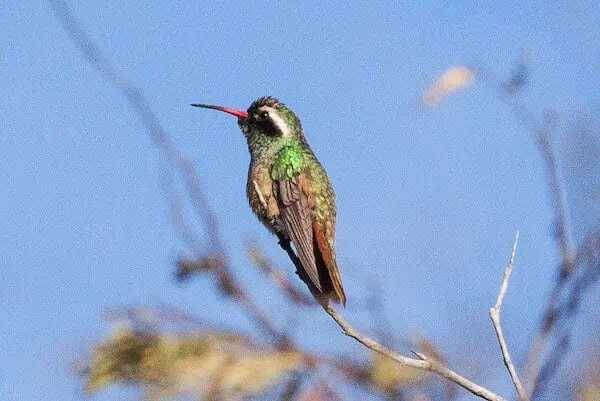
Scientific name:
Range: southern half of Baja California peninsula
The Xantu’s hummingbird looks a lot like its “sibling” species, the white-eared hummingbird. However they are separated by the Gulf of California and the Xantu’s is only endemic to the Baja peninsula. While they share the same eye stripe, green body and beak coloring, only the Xantu’s has hues of cinnamon and rusty brown in its underparts and tail.
Xantu’s shares a mutually beneficial relationship with a local tree, the Baja madrone. The tree provides nectar in late winter and early spring when not many other plants are in bloom, and in return the hummingbird acts as it’s main pollinator. Occasionally Xantu’s are spotted in southern California.

Scientific name:
Range: eastern coast of Mexico, Yucatan peninsula, Central America, Ecuador, coastal Venezuela
A larger and bulkier hummingbird of the high canopy. Males and females each have unique features.
The green-breasted mango eats a diet high in insects. They are often seen perching and feeding high up in the tree canopy, but may also visit feeders.
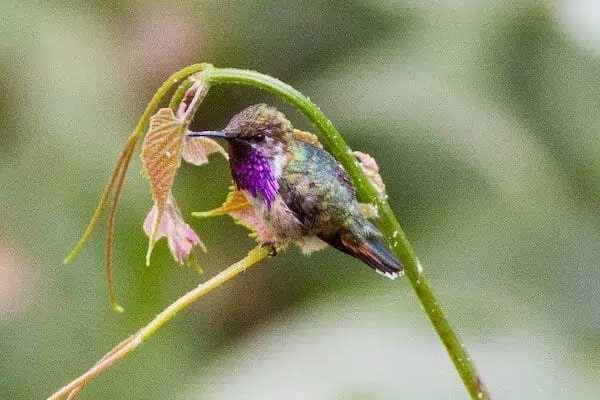
Scientific name:
Range: Mexico (humid mountain forests)
This hummingbird is named for its tiny size, about as big as a bumble bee! These hummingbirds have green upper parts, a short black bill, and a tail banded in rust, black and white. Males have some buffy wash on their sides and magenta-pink throat feathers that are slightly elongated and pointed. Females have strong rufous coloring on their sides and a pale throat with some speckling and sometimes a pink feather or two.
They often feed at flowers with shorter tubes, and their slow and steady flight resembles that of a large bee.
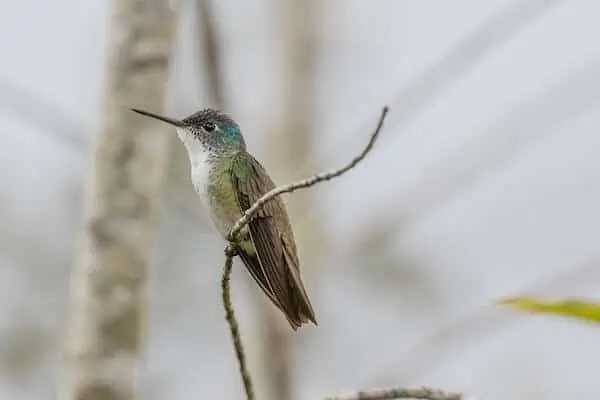
Scientific name:
Range: eastern Mexico, Central America to Nicaragua
Despite their name, these hummingbirds aren’t very brightly colored. Males and females look alike, with a brownish-green back and sides, white throat and chest, and blueish head. While their heads may look dark, in the right light you can see their dark blue crown, blending to a more turquoise blue at the back of the head.
Not much is known about these hummingbirds as they have not been widely studied, but they have been observed gathering in large numbers around flowering trees.
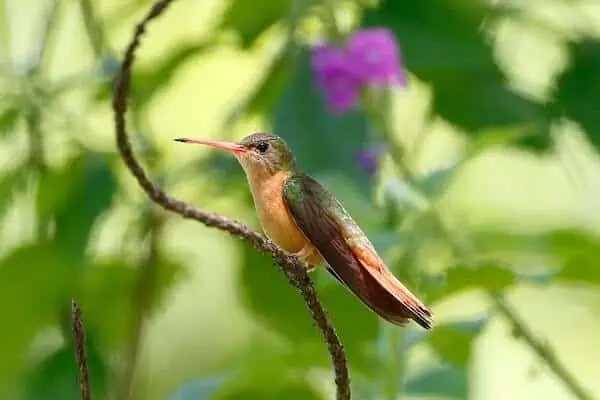
Scientific name:
Range: western Mexico, Yucatan Peninsula, Central America
This medium-sized hummingbird can be found in dry tropical lowlands, including woodland edges and gardens. You can see where they get their name, with their tail and underparts up through their chest being a warm cinnamon brown. Their head and back are a grassy green, and they sport a red beak with black tip.
Both sexes share the same coloring, and are known to be aggressive and territorial when it comes to defending their nectar sources.
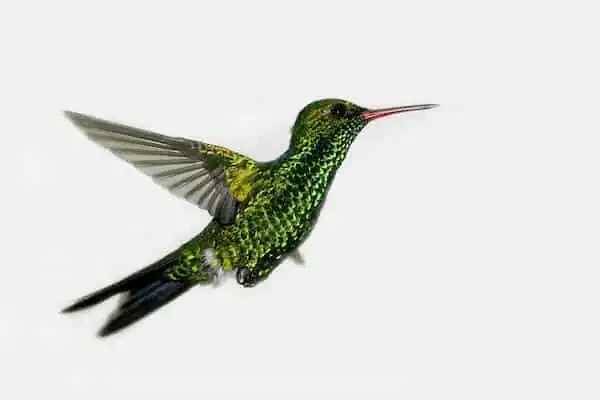
Scientific name:
Range: eastern coast of Mexico, Yucatan Peninsula, Central America
If you’ve been wondering if there is an all-green hummingbird, the answer is yes. The male Canivet’s emerald lives up to its name and is fully covered in iridescent green, with a red bill. Females sport a green back, a white face with black eye-stripe, and a pale throat, chest and belly. So far, they have not been recorded traveling north of Mexico.